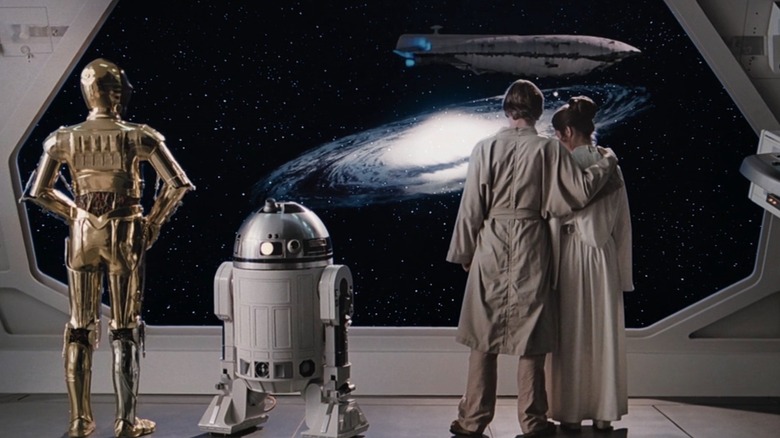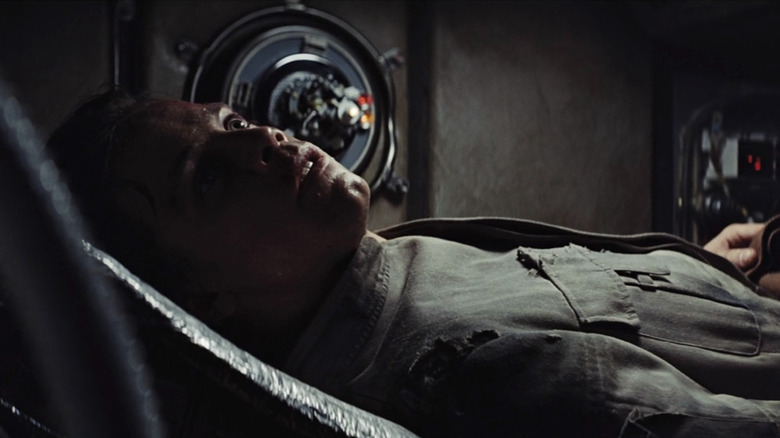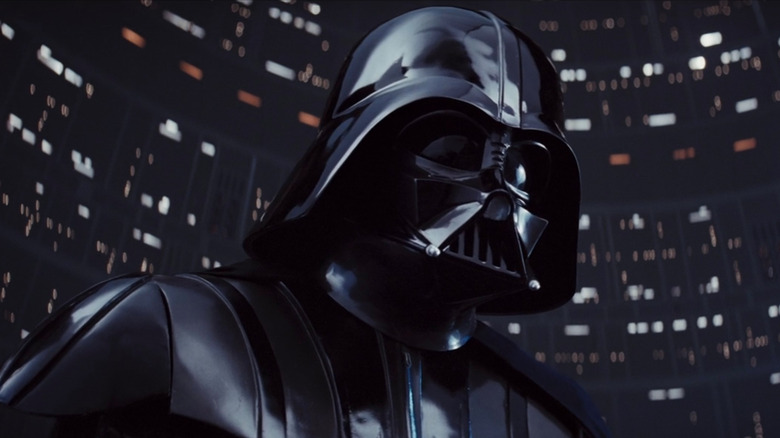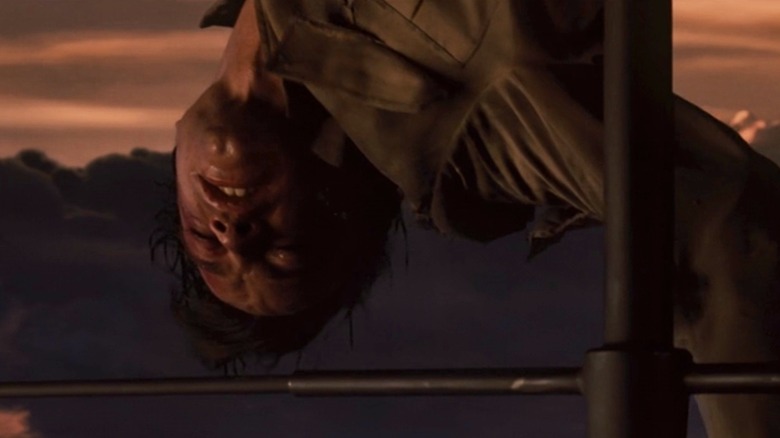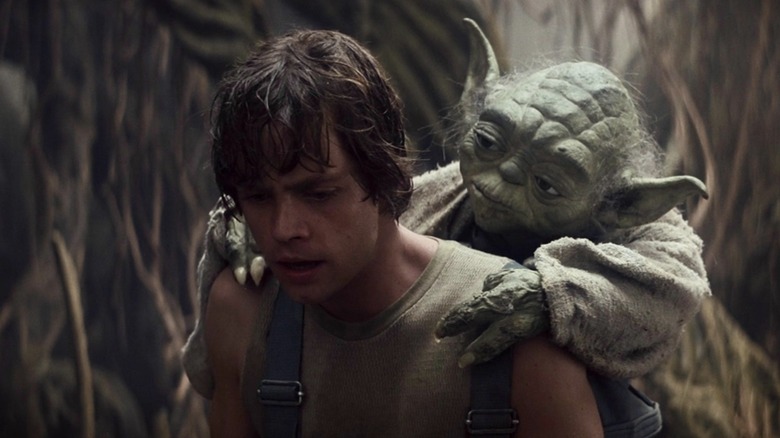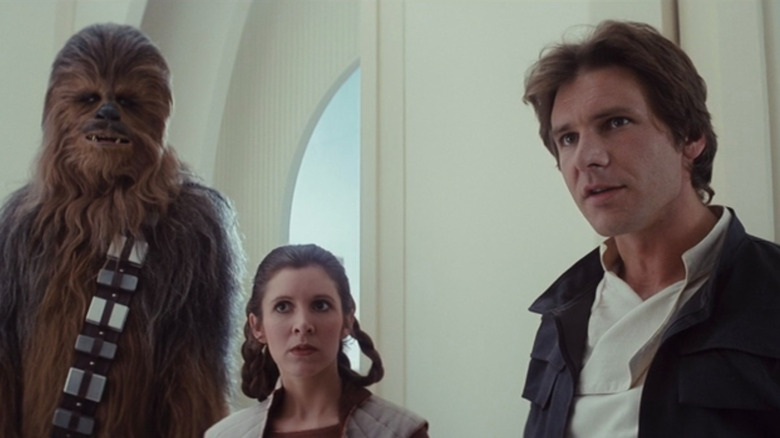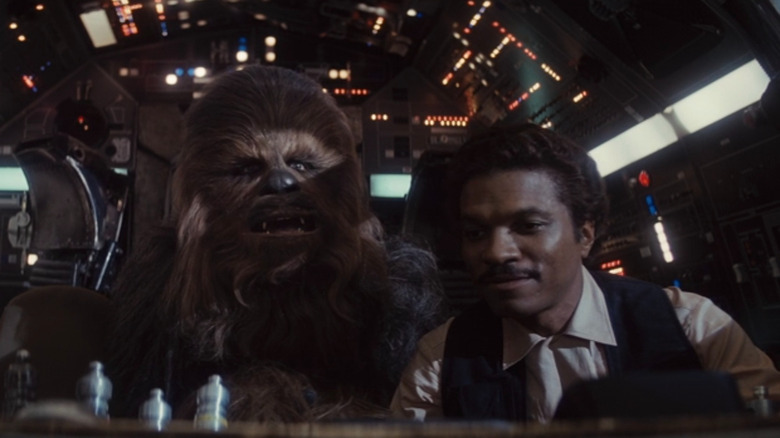The Empire Strikes Back Ending Explained: 'To Just Have Survived Is To Get Pretty Far In This Life Sometimes'
This post contains spoilers for "The Empire Strikes Back."
In 1980, "The Empire Strikes Back" had already screened in about a hundred theaters when executive producer and "Star Wars" creator George Lucas decided that the ending was confusing and needed some last-minute changes. According to StarWars.com, before the movie expanded its theatrical rollout any further, Lucas had the team at Industrial Light & Magic add shots to give clarity to the geography of the Millennium Falcon in relation to the medical frigate where Luke Skywalker (Mark Hamill), Princess Leia (Carrie Fisher), and the droids C-3PO (Anthony Daniels) and R2-D2 (Kenny Baker) stand looking out the window.
It wouldn't be the last time Lucas tinkered with "The Empire Strikes Back," as the version that's now streaming on Disney+ incorporates further changes he made for its 1997 Special Edition re-release. In 2022, Hamill revealed that the medical frigate scene was itself a late addition shot four months after principal photography for "The Empire Strikes Back" wrapped. Responding to a fan question on Twitter, the actor said the filmmakers were "concerned about the downbeat ending and thorough defeat of the protagonists" and "wanted to add an uplifting moment of hope and rejuvenation to reassure the audience."
The ending of "The Empire Strikes Back" is not intellectually confusing, but regardless of how much it has seeped into public awareness by now, it still might be emotionally confusing for someone who is new to "Star Wars." Director Irvin Kershner explained the lack of triumph for the heroes by saying (via The Hollywood Reporter), "To just have survived is to get pretty far in this life sometimes." In the movies and in life, Kershner said, "If you expect certain things to happen, they never will happen the way you expect them."
'Ben, why didn't you tell me?'
The biggest, most famous twist "The Empire Strikes Back" delivers is the revelation that Darth Vader (David Prowse) is Luke Skywalker's father. It's one of the greatest twists in movie history, but it also seems to conflict with what Obi-Wan Kenobi (Alec Guinness) told Luke in the first "Star Wars" movie: that Vader "betrayed and murdered" his father, Anakin Skywalker.
The third and final film in the original "Star Wars" trilogy, "Return of the Jedi," helps to explain this apparent contradiction, but since we're focused on "The Empire Strikes Back" here, it seems unfair to bring in knowledge of its sequel. If you're just watching "The Empire Strikes Back" in a vacuum, you might think Vader is lying when he says he's Luke's father, and in fact, that's Luke's first reaction, too. As he clings to the catwalk in Cloud City, Luke says, "That's not true. That's impossible!"
Vader, however, voiced by James Earl Jones, quickly counters, "Search your feelings, you know it to be true." And by the end of "The Empire Strikes Back," Luke has accepted that this is the truth, not some villainous ploy. He's already calling Vader "father" and praying to Obi-Wan's Force ghost, saying, "Ben, why didn't you tell me?"
The movie leaves that question unanswered until its sequel, but in the short term, it would appear that making Vader Luke's father was a bit of retroactive continuity. One thing we can say here, without spoiling "Return of the Jedi," is that not every question raised by "The Empire Strikes Back" would be answered onscreen. There's also the question, "When and how did Darth Vader learn that Luke was his son?" The trilogy never explicitly answers that question, but a canonical tie-in comic would do it in 2020.
Movie history's greatest retcon
"The Empire Strikes Back" changed the dynamic of the whole "Star Wars" saga, but as much as George Lucas might claim to have planned out the first six movie episodes beforehand, there's evidence to suggest he was making some things up as he went along. In 2019, author and Lucasfilm creative art manager Phil Szostak confirmed in a Twitter thread that the Vader-is-Luke's-father twist didn't enter "Star Wars" history until screenwriter Leigh Brackett died and Lucas and Lawrence Kasdan undertook the second draft of "The Empire Strikes Back" script.
In the 2022 VICE TV documentary, "Icons Unearthed: Star Wars" (via Inverse), a key figure all but written out of franchise history, Marcia Lucas (George's ex-wife and the co-editor of "A New Hope" and "Return of the Jedi"), said that the idea for the twist/retcon originated from a dinner party joke made by Willard Huyck, the co-screenwriter of Lucas' pre-"Star Wars" masterpiece, "American Graffiti." The origins of the twist don't detract from its dramatic impact, but it's helpful to understand how they may have informed the organic development of "The Empire Strikes Back." With this movie, "Star Wars" was in the middle of course-correcting itself, or maybe just deciding on a course and a grand design for the whole mythos now that the success of the first film in 1977 had made that possible.
After he cuts Luke's hand off, Vader tries to use the revelation of his parentage to his advantage, tempting Luke into joining him so they can "rule the galaxy as father and son." At this point, Luke is in dire need of escape, so thoroughly outmatched and "beaten" (as Vader says), that his only course of action is to throw himself into the gaping chasm of the reactor shaft in Cloud City.
Why Luke Skywalker fails
"The Empire Strikes Back" leaves the audience in as much uncertainty as Luke Skywalker, whose entire world, as StarWars.com notes, "is literally and figuratively turned upside down, as he is stranded on a weather vane beneath Cloud City." It's moments like this when a young Jedi can only look back at where they might have gone wrong.
For Luke, the warning signs were there on Dagobah, the swamp planet where he left his training unfinished with the Jedi master Yoda, the most soulful Muppet a viewer is ever likely to meet. Voiced and performed through down-to-the-wire puppetry by Frank Oz, Yoda and the Zen wisdom that shine through his backward way of talking help give "The Empire Strikes Back" added gravitas, a deeper spiritual dimension than any other "Star Wars" movie. This begins with the lesson that appearances can be deceiving.
When Yoda first intrudes on Luke's camp, Luke underestimates him because of his size and kooky demeanor. He never once stops to consider that this little green creature might be the Jedi master he's seeking. In the same way, after half-completing his training with Yoda, Luke overestimates his own readiness and underestimates Darth Vader and the Emperor (Ian McDiarmid), the latter of whom makes his first onscreen appearance in holographic form in "The Empire Strikes Back."
This jibes with Luke's character, perhaps best encapsulated by the classic "Star Wars" image of him as a farm boy, watching a binary sunset on the desert planet where he grew up. It makes sense that Yoda, using the Force, would want to keep an eye on Anakin Skywalker's son, and he says of Luke, "All his life has he looked away, to the future, to the horizon. Never his mind on where he was, what he was doing."
'The quick and easy path'
Yoda is initially hesitant to even train Luke Skywalker, observing that he's "reckless" and questioning whether he'll "finish what he begins." Luke doesn't, because he has a premonition of his friends, Princess Leia and Han Solo (Harrison Ford), in great pain. Yoda says that the future, as glimpsed through the Force, is "always emotion," and later dialogue suggests that Han undergoes torture for the express purpose of making him feel pain that will resonate across the galaxy to Luke through the Force.
"They never even asked me any questions," Han says of his torturers, and this is because they don't need anything from him other than to draw Luke out. "It is you and your abilities the Emperor wants," Yoda tells Luke. "That is why your friends are made to suffer."
Luke is afraid Han and Leia will die, but as Obi-Wan Kenobi's Force ghost says, he can't know that will happen, and it's really part of Darth Vader's plan to make him fear that it will. Yoda also floats the possibility that Luke, as a Jedi, should be willing to make the hard choices and sacrifice his friends if he honors their ongoing fight as Rebels. "Decide you must," he says, "how to serve them best. If you leave now, help them you could, but you would destroy all for which they have fought and suffered."
The implication is that Leia and Han wouldn't want Luke to come save them if it meant the Empire winning. Unfortunately, Luke has more than a little of his father in him, as shown in the cave scene where he beheads Vader, only to see his own face staring back at him from behind Vader's skull-like mask. So he chooses "the quick and easy path" Yoda warned against.
Meanwhile, in Cloud City...
Spare a word for Lando Calrissian (Billy Dee Williams), the administrator of Cloud City, and the B story of "The Empire Strikes Back." As Lando leads his old pal, Han Solo, and Princess Leia and Chewbacca (Peter Mayhew) into Darth Vader's clutches, he lays out the reasons for his pending betrayal. Cloud City is a small operation that functions below the radar of the mining guild and Imperial jurisdiction, and "it's always been a danger" that the Empire would find out about it, but he's "just made a deal that will keep the Empire out of here forever."
Lando means well and doesn't want to betray Han, but he's responsible for an entire city full of people, whose welfare comes above that of one old gambling buddy. It's Han's own fault, anyway, that he's got the bounty hunter Boba Fett (Jeremy Bulloch) after him. Toward the beginning of the movie, Han is preparing to leave the ice planet Hoth so he can go pay off Jabba the Hutt, the gangster and giant CG slug who's been digitally inserted into "Star Wars: A New Hope" since 1997.
Han's backstory, parceled out in "A New Hope," involves him being a smuggler who cost Jabba money when he dropped his "shipments at the first sign of an Imperial cruiser." This is why he had that cantina showdown with another green alien bounty hunter, Greedo, back when we first met him.
In "The Empire Strikes Back," Han's past finally catches up with him, but he matters so little to Darth Vader that Vader is willing to compensate Fett for the lost bounty if Han dies as a human guinea pig in the carbon-freezing process (which Vader plans to use on his real target, the greatest "Star Wars" character, Luke Skywalker).
Pyrrhic victory
Han Solo's fate is left hanging at the end of "The Empire Strikes Back," in part because of Harrison Ford's reluctance to return to the role. However, it helps Lando Calrissian see how the ever-changing terms of his deal with Darth Vader keep getting progressively worse, which leads Lando to free Princess Leia and Chewbacca, evacuate Cloud City, and eventually set out to rescue Han at the end of the movie.
Before Luke Skywalker takes the bait and leaves Dagobah, Yoda identifies fear as one of the emotional triggers for the Dark Side, and he warns Luke that "a Jedi uses the Force for knowledge and defense, never attack." Yet when Luke gets to Cloud City, driven by the fear of losing his friends, he's the first to activate his lightsaber and swing it, going on the offensive, attacking Vader, and playing right into his hands.
In the end, the road to Luke's defeat is paved with his own naive mistakes, but if you think about what director Irvin Kershner said, Luke is a novice Jedi who survives a one-on-one fight with Darth Vader himself. Against such overwhelming odds, just surviving like that can be regarded as a kind of success or pyrrhic victory. Of note, too, is the fact that Vader's triumph is short-lived. His part of the movie also ends with him staring out the window, having failed to catch the Millennium Falcon before it made the jump to hyperspace and escaped.
Since 1980, "The Empire Strikes Back" has become the gold standard by which all other dark middle movie chapters are judged. If you, like Luke, want to complete your Jedi training and know how the rest of the story plays out after this cliffhanger ending, you'll just have to watch "Return of the Jedi."
